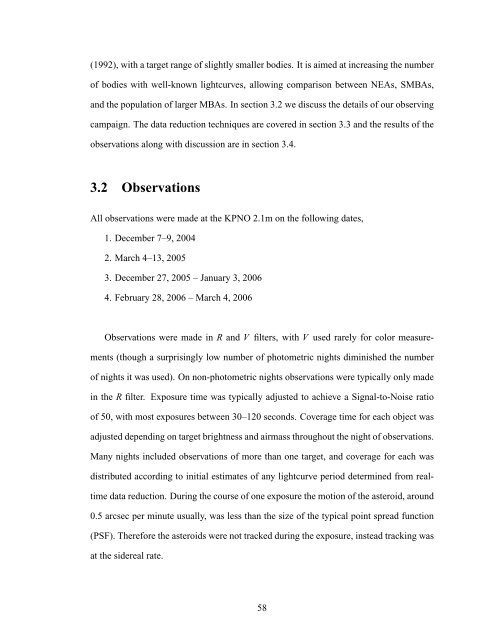Forming Binary Near-Earth Asteroids From Tidal Disruptions
Forming Binary Near-Earth Asteroids From Tidal Disruptions
Forming Binary Near-Earth Asteroids From Tidal Disruptions
You also want an ePaper? Increase the reach of your titles
YUMPU automatically turns print PDFs into web optimized ePapers that Google loves.
(1992), with a target range of slightly smaller bodies. It is aimed at increasing the numberof bodies with well-known lightcurves, allowing comparison between NEAs, SMBAs,and the population of larger MBAs. In section 3.2 we discuss the details of our observingcampaign. The data reduction techniques are covered in section 3.3 and the results of theobservations along with discussion are in section 3.4.3.2 ObservationsAll observations were made at the KPNO 2.1m on the following dates,1. December 7–9, 20042. March 4–13, 20053. December 27, 2005 – January 3, 20064. February 28, 2006 – March 4, 2006Observations were made in R and V filters, with V used rarely for color measurements(though a surprisingly low number of photometric nights diminished the numberof nights it was used). On non-photometric nights observations were typically only madein the R filter. Exposure time was typically adjusted to achieve a Signal-to-Noise ratioof 50, with most exposures between 30–120 seconds. Coverage time for each object wasadjusted depending on target brightness and airmass throughout the night of observations.Many nights included observations of more than one target, and coverage for each wasdistributed according to initial estimates of any lightcurve period determined from realtimedata reduction. During the course of one exposure the motion of the asteroid, around0.5 arcsec per minute usually, was less than the size of the typical point spread function(PSF). Therefore the asteroids were not tracked during the exposure, instead tracking wasat the sidereal rate.58












